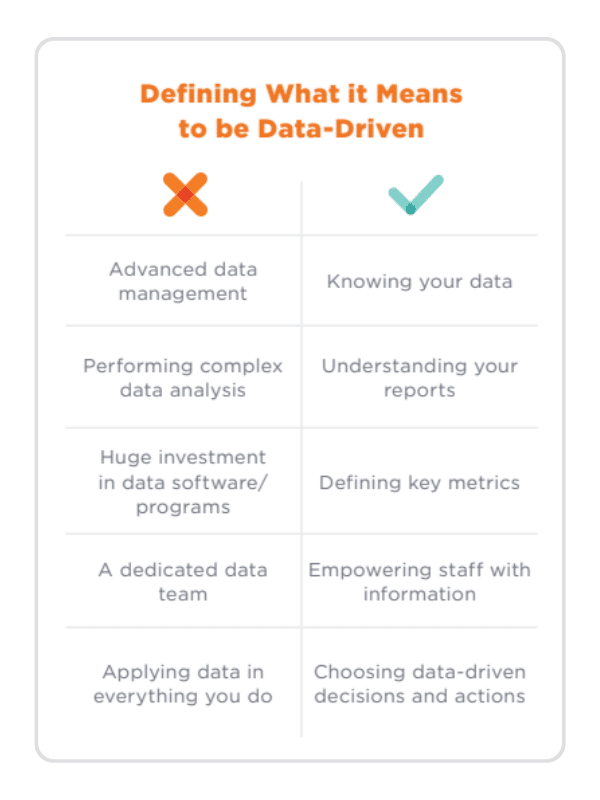How to Use Your Data to Be Member-Centric
Leveraging your member data to increase engagement is a combination of knowing what to use your data FOR and knowing how to APPROACH your data to make it usable. In this guide, we’ll walk through both!

Data – and being able to use it – is often what separates highly successful, proactive organizations from organizations that are just getting by. Data is essential for:
- Gaining insights into what your audience needs and increasing member engagement.
- Gauging the health of your organization and the impact of your efforts.
- Creating the personalized, targeted experiences today’s members are looking for.
You can’t segment your email marketing lists, make targeted educational suggestions, or tailor your messaging to specific member types without data.
The good thing is, your organization probably has access to a lot more data than you think. Every platform you use to engage your members – from your online community software, to your marketing automation platform, to your learning management system (LMS) can help you learn more about your members. And if those systems are connected and/or integrated, it makes it easier to use that data.
In this guide, we’ll walk through some examples for how you can can USE your data and then outline how to ensure your data is USABLE.
Common Uses for Your Member Data
Measure and Analyze Performance and Strategies
If you’re not monitoring your performance data, you’re basically running on vibes. While that might seem easier at first, it leads to missed opportunities, mistaken assumptions, and decisions that might not be in the best interest of your organization or members.
Using your data to help you adjust your strategies and measure success can help you improve on what’s working, and figure out what’s NOT working before it leads to a crisis. Common performance data you’ll want to keep an eye on might include:
Community metrics like monthly logins, unique users, discussion posts and replies, unique discussion contributors, and library entries.
Email metrics like deliverability rate, open rate, click rate, unsubscribe rate, and conversion rate.
Membership metrics like member retention rate, member satisfaction, and anything else you measure in membership services surveys.
Event and education participation metrics like registration numbers, live attendance for webinars, and satisfaction rate.
Look for trends over time and consider setting up notifications or alerts for anomalies or targets.
Think about how these metrics overlap, too. For example, does your member retention rate improve when you see more community engagement, event participation, and/or email engagement? The American Society of Association Executives (ASAE) noticed, when reviewing their data, that members who renewed had over 50% more community activities than members who did not renew – showing community engagement as an indicator of member engagement and satisfaction.

Making Your Member Data Usable
So you have ideas for how you might like to use your member data… now what? With the right systems, like Higher Logic’s interconnected technology ecosystem, your data is a lot easier to use because AI and automation are built-in and all your systems are designed to work together. But it still helps to have a healthy understanding of some of the ways you can make it easier to use and apply your data.
Below, we’ll explore four essential steps that help you use your data effectively:
- Create a data process.
- Use a data framework.
- Validate your data.
- Centralize your data.

1. Create a Data Process
You don’t need to be a data scientist to explore what your data can tell you and how you want to use it. Becoming more data-driven and member-centric starts with understanding the data that’s available to you, and then exploring practical ways your team can use it.
You need to understand why each metric is important and how it impacts your bottom line.
Start by asking these questions about the data you have in each of your systems (e.g. your AMS, your marketing automation platform, your LMS, etc.):
- Why do we collect this information?
- Who uses it?
- Why is it important
Next, define your metrics by building a data dictionary.
This ensures everyone is clear what you mean, as an organization, when you use terms like “active members,” “inactive members,” “member retention,” or “engagement”. It can be as simple as a 10-row spreadsheet with a term and a quick definition. This document can be a “living” resource that you continually refer to and improve over time – it’s simply helpful to have your terms documented so everyone is on the same page.
Then, discuss how you define those terms in data.
This will include exploring the types of data you have access to that can tell you something, including:
- For your organization, what are the key markers of an engaged member? And have you considered what those markers are across different platforms? What does it mean for someone to be engaged with your…
- Community (logins, discussion posts)
- Emails (open rates, click rates, conversion rates)
- Programs on your website (webpage visits)
- Learning Management System (LMS) (participation in specific educational content)
- Job board (logins, job postings)
- What information in your AMS would indicate that someone is engaged? (e.g. years as a member, involvement in volunteering, registration for events)
- What is your member retention rate?
- How do you measure member satisfaction? (e.g. benefit usage, engagement)
- What types of things do people engage with? (e.g. certain topics, formats, levels of difficulty)
Once you understand what information you have and what it can tell you, you can explore how to work data into your day-to-day operations to make data-driven decisions and improve the member experience. These operationalization tactics might include:
- Exploring ways to improve the data cleanliness in your database.
- Setting a schedule for pulling reports and reviewing them with stakeholders.
- Using datapoints to refine how you segment your marketing lists to improve the relevance of your outreach.
- Identify if there’s information you need that you don’t have, and look into how you can ethically collect that information (e.g. a new question in your membership services survey, an inquiry via a community polls, a new field in your AMS)

2. Use a Data Framework
Did you know that 85% of data projects fail due to things like unclear objectives, poor data quality, and inadequate implementation? Having a data framework to guide your preparation for any data project can be incredibly helpful for ensuring success. A data framework can help you choose the right questions to ask and understand the data you’ll need to answer those questions. It can also help you avoid vanity metrics – pulling data for data’s sake – and push you toward projects that will lead to actions and achieving organizational goals.
Here’s one example of a data framework:
- Question – what question are you trying to answer with the data?
- Action – what action will the data help you take?
- Data – what data do you have (or do you need) that would help you answer this question and take action? And is that data something you can repeatedly pull and refer to?
- Definitions – what are the terms you’re using as part of this project? Define them and make sure everyone is on the same page.
- Process – outline how you’re getting the data and how it will be used.
Understanding each piece of this framework — question, action, data, definitions, and process — ahead of any actual work sets your team up for success.
Learn How to Use This Data Framework
3. Validate Your Data
You have a lot of data on your members – and you should use it! But when you’re getting insights from data, it’s important to understand how reliable the data is.
To get insights from your data and be able to use those insights to take action, there are three ways you should evaluate your data to ensure that the insights you get from that data are trustworthy and meet your standards.
- Identify data types and ensure that those data types align with what you hope to use them for.
- Determine data quality, considering completeness, timeliness, validity, consistency, and integrity.
- Use data aggregation methods to review your data and see if there are any outlying data points in your data set that might skew your analysis and conclusions.
When you have a healthy understanding of the accuracy, quality, and limitations of your data, you’re better prepared to get reliable insights from it.
Learn How to Validate Your Data
4. Centralize Your Data
This fourth step is more of an overarching strategy than a project-specific task. Being data-driven is easier when the sources of your data are connected or centralized.
This is because in order to act on the data you have, you have to be able to access and use it throughout your systems. For example, you might want to send targeted email outreach to members based on the actions they’ve taken in your community and/or LMS. If your community and LMS are connected to, or integrated with your marketing automation platform, that process might only take one step vs. multiple.
Now more than ever, organizations will need a centralized source of data or seamless integration between their technologies and systems to meet modern expectations. This foundation is essential for enabling the segmentation and personalization that fuel stronger engagement. Being able to access all your data throughout your systems creates an environment where associations can easily track engagement, identify trends, and make data-driven decisions to enhance member satisfaction and retention. Additionally, centralized data helps in maintaining data accuracy and compliance with privacy regulations.
And, even more exciting, powering up your processes with AI will also be easier if your data is easy to access.
Member Data Helps You Serve Members
As an association, you have a responsibility to know your members. The data you have not only helps you better understand members but also act on what you know to deliver personalized recommendations and content. The more members you have, the harder that will be. But with the right tools, and a plan to properly collect, analyze, and act on your data, you can give your members a better overall experience and prove ongoing value.
Related Resources
Your Online Community is a Data Goldmine
Build vital connections between your customers, members, and employees. Learn how to manage and take action on all your community...
Read MoreAI Assistants and Agents: Smart Responses, Seamless Automation
Whether you’re an AI advocate or a skeptic, this webinar provides a look at its practical application.
Read MoreHarnessing the Power of Human Community and AI with watsonx
Higher Logic collaborated with IBM to embed watsonx into our platform, giving online communities like IBM TechXchange on-demand answers.
Read More







